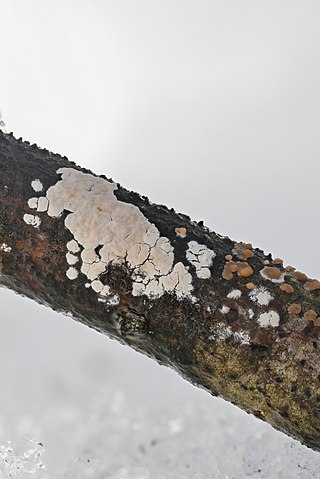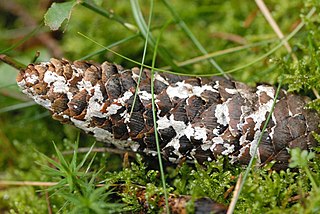
The Cantharellaceae are a family of fungi in the order Cantharellales. The family contains the chanterelles and related species, a group of fungi that superficially resemble agarics but have smooth, wrinkled, or gill-like hymenophores. Species in the family are ectomycorrhizal, forming a mutually beneficial relationship with the roots of trees and other plants. Many of the Cantharellaceae, including the chanterelle, the Pacific golden chanterelle, the horn of plenty, and the trumpet chanterelle, are not only edible, but are collected and marketed internationally on a commercial scale.

The Clavariaceae are a family of fungi in the order Agaricales. Originally the family contained most of the clavarioid fungi, but in its current sense is more restricted, albeit with a greater diversity of basidiocarp forms. Basidiocarps are variously clavarioid or agaricoid (mushroom-shaped), less commonly corticioid or hydnoid.

The Clavulinaceae are a family of fungi in the order Cantharellales. The family is not well defined, but currently comprises species of clavarioid fungi as well as some corticioid fungi. These species are nutritionally diverse, some being ectomycorrhizal, others wood-rotting saprotrophs, others lichenized, and yet others lichenicolous.

Corticium roseum is a species of fungus in the family Corticiaceae. Basidiocarps are effused, smooth, corticioid, and pink. The species has a wide, north and south temperate distribution and in Europe is typically found on dead, attached branches of Salix and Populus.

Phanerochaete is a genus of crust fungi in the family Phanerochaetaceae.

The Hydnaceae are a family of fungi in the order Cantharellales. Originally the family encompassed all species of fungi that produced basidiocarps having a hymenium consisting of slender, downward-hanging tapering extensions referred to as "spines" or "teeth", whether they were related or not. This artificial but often useful grouping is now more generally called the hydnoid or tooth fungi. In the strict, modern sense, the Hydnaceae are limited to the genus Hydnum and related genera, with basidiocarps having a toothed or poroid hymenium. Species in the family are ectomycorrhizal, forming a mutually beneficial relationship with the roots of trees and other plants. Hydnum repandum is an edible species, commercially collected in some countries and often marketed under the French name pied de mouton.

The Corticiaceae are a family of fungi in the order Corticiales. The family formerly included almost all the corticioid fungi, whether they were related or not, and as such was highly artificial. In its current sense, however, the name Corticiaceae is restricted to a comparatively small group of corticioid genera within the Corticiales.

Atheliaceae is a family of mostly corticioid fungi placed in the order Atheliales. Both the order and the family were described by the Swiss mycologist Walter Jülich in 1981 along with three other families, Lobuliciaceae, Byssocorticiaceae, Pilodermataceae and Tylosporaceae discovered in 2020. According to a 2008 estimate, the family contains 20 genera and approximately 100 species. However, many genera formerly considered to belong in the Atheliaceae have since been moved to other families, including Amylocorticiaceae, Albatrellaceae, and Hygrophoraceae. Despite being a relatively small group with inconspicuous forms, Atheliaceae members show great diversity in life strategies and are widespread in distribution. Additionally, being a group strictly composed of largely corticioid fungi, they may also provide insights on the evolution of fruiting body forms in basidiomycetes.

The Phanerochaetaceae are a family of mostly crust fungi in the order Polyporales.

The Botryobasidiaceae are a family of fungi in the order Cantharellales. The family contains a group of corticioid fungi that form thin, web-like basidiocarps. Some species form asexual anamorphs producing chlamydospores. All are believed to be wood-rotting or litter-rotting saprotrophs. None is known to be of any economic importance.

The Corticiales are an order of fungi in the class Agaricomycetes. The order is composed of corticioid fungi. Species within the order are generally saprotrophic, most of them wood-rotters, but several are parasitic on grasses or lichens. Plant pathogens of economic importance include Erythricium salmonicolor, Laetisaria fuciformis, Waitea circinata, Waitea oryzae, and Waitea zeae.

Peniophora is a genus of fungi which are plant pathogens. Members of the genus belong to the class Agaricomycetes, order Russulales, and family Peniophoraceae. The genus is widespread, and contains 62 species. The species of Peniophora are resupinate, or crust-like, and are described as corticioid. A number of its members are parasitised by other fungi. For example, Tremella mesenterica is a parasite to several species of Peniophora.

Corticium is a genus of fungi in the family Corticiaceae. Basidiocarps are effused, corticioid, smooth, and grow on dead wood. One species, C. silviae, is lichenicolous. The genus was formerly used in a very wide sense for almost any effused corticioid fungi.
Pirex is a fungal genus in the family Meruliaceae. It is a monotypic genus, containing the single crust fungus Pirex concentricus. It is found in the Pacific Northwest region of North America, where it causes a white rot in woody hardwood and conifer debris generated by timber harvesting.

Dentocorticium is a genus of six species of poroid fungi in the family Polyporaceae. The genus was revised in 2018, with several new species added and some older species transferred to other genera, based on phylogenetic analyses.

The corticioid fungi are a group of fungi in the Basidiomycota typically having effused, smooth basidiocarps that are formed on the undersides of dead tree trunks or branches. They are sometimes colloquially called crust fungi or patch fungi. Originally such fungi were referred to the genus Corticium and subsequently to the family Corticiaceae, but it is now known that all corticioid species are not necessarily closely related. The fact that they look similar is an example of convergent evolution. Since they are often studied as a group, it is convenient to retain the informal (non-taxonomic) name of "corticioid fungi" and this term is frequently used in research papers and other texts.
The Vuilleminiaceae are a family of fungi in the order Corticiales. The family in its current sense is based on molecular research and contains just three genera of temperate corticioid fungi.
Hyphodontiella is a genus of two species of wood-inhabiting corticioid fungi. The genus contains two species found in Nordic countries. Hyphodontiella was circumscribed by Swedish mycologist Åke Strid in 1975. Originally classified in the family Corticiaceae along with most other corticioid fungi, it was moved to the Clavariaceae in 2007.
Lyoathelia is a fungal genus in the family Atheliaceae. The genus is monotypic, containing the single corticioid (crust-like) species Lyoathelia laxa. Originally found in Canada, it is now known to occur as well in the United States and Japan.

Botryobasidium is a genus of corticioid fungi belonging to the order Cantharellales. Basidiocarps are ephemeral and typically form thin, web-like, white to cream, effused patches on the underside of fallen branches, logs, and leaf litter. Several species form anamorphs producing chlamydospores. All species are wood- or litter-rotting saprotrophs and the genus has a worldwide distribution.













